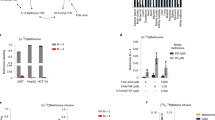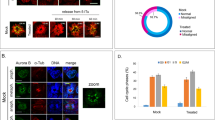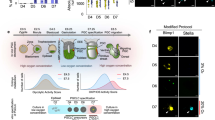Abstract
METHOTREXATE (amethopterin) blocks the activity of the enzyme dihydrofolic reductase and thereby interferes with a number of metabolic reactions involving the transfer of carbon atoms, including the production of thymidylate, de novo purine biosynthesis, and inter-conversions of several amino-acids. Partial reversal of toxicity induced by antifolics such as methotrexate by the addition of purine and thymine sources has been reported for amphibian1 and avian2,3 embryos, but similar experiments with rat embryos were unsuccessful4. The deficiencies induced by methotrexate can be completely reversed in mammalian tissue culture systems, however, by the inclusion in the nutrient fluid of a purine source, certain amino-acids, and a thymine source, usually thymidine5–8. If thymidine is omitted from the medium, a deficiency develops, sometimes called the thymineless state, in which the cells begin to die after approximately one generation time. It seemed desirable to attempt to reproduce this condition in vivo, in order better to define the mode of action of methotrexate, as well as to provide information which might be used to control cell growth in vivo.
This is a preview of subscription content, access via your institution
Access options
Subscribe to this journal
Receive 51 print issues and online access
$199.00 per year
only $3.90 per issue
Buy this article
- Purchase on Springer Link
- Instant access to full article PDF
Prices may be subject to local taxes which are calculated during checkout
Similar content being viewed by others
References
Grant, P., Dev. Biol., 2, 197 (1960).
Snell, E. E., and Cravens, W. W., Proc. Soc. Exp. Biol. Med., 74, 87 (1950).
Cravens, W. W., and Snell, E. E., Proc. Soc. Exp. Biol. Med., 75, 43 (1950).
Kinney, C. S., and Morse, L. M., J. Nutrit., 84, 288 (1964).
Hakala, M. T., and Taylor, E., J. Biol Chem., 234, 126 (1959).
Rueckert, R. R., and Mueller, G. C., Cancer Res., 20, 1584 (1965).
Morse, P. A., and Potter, V. R., Cancer Res., 25, 499 (1965).
Gentry, G. A., Morse, P. A., and Potter, V. R., Cancer Res., 25, 509 (1965).
Morse, P. A., Pyrimidine Metabolism of Rat Hepatomas in Tissue Culture (Univ. Wisconsin, 1963).
Sherman, J. D., and Dameshek, W., Nature, 197, 469 (1963).
Mclntire, K. R., Sell, S., and Miller, J. F. A. P., Nature, 204, 151 (1964).
East, J., and Parrott, D. M. V., J. Nat. Cancer Inst., 33, 673 (1964).
Author information
Authors and Affiliations
Rights and permissions
About this article
Cite this article
GENTRY, G., MORSE, P. Partial Reversal of the Thymineless State in vivo. Nature 212, 1483–1484 (1966). https://doi.org/10.1038/2121483a0
Issue Date:
DOI: https://doi.org/10.1038/2121483a0
Comments
By submitting a comment you agree to abide by our Terms and Community Guidelines. If you find something abusive or that does not comply with our terms or guidelines please flag it as inappropriate.



